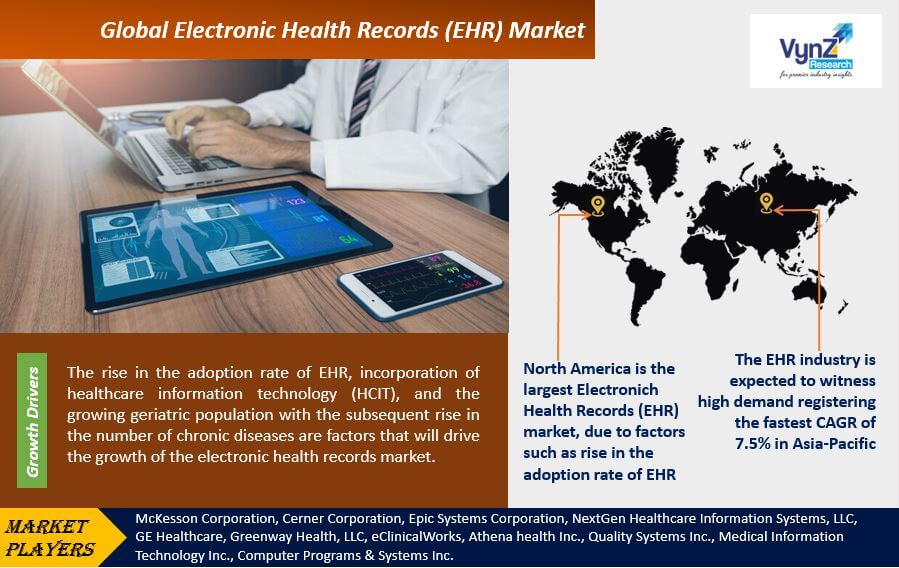| Status : Published | Published On : Dec, 2024 | Report Code : VRHC1004 | Industry : Healthcare | Available Format :

|
Page : 121 |

Global Electronic Health Records (EHR) Market - Analysis and Forecast (2025-2030)
Industry Insights by Product (Solutions Services), by Mode of Delivery (Web based/ Cloud based, Client based server), by End-User (Hospitals, Ambulatory Care Pharmacies Others), and by Geography (North America, Europe, Asia-Pacific, Middle East, South America and Rest of the World)
Industry Overview
The Global Electronic Health Records (EHR) Market was valued at USD 36.4 billion in 2023 and the market size is predicted to grow at a CAGR of 7.9% during the forecast period The EHR market provides healthcare facility by web-based/cloud-based and client-based server mode of delivery options. Among the available categories, the web-based mode of delivery is high in demand, with a market share of more than 50% in the EHR market, globally.

Electronic health records, more commonly known as EHR are digitalized collections of patient health records. This EHR is used by healthcare providers to analyze clinical information and facilitate suitable healthcare options. Protecting patient data from unauthorized access, breaches, or misuse is crucial. Healthcare organizations must adhere to strict privacy and security regulations, implement robust security measures, and train staff to handle sensitive patient information securely.
The EHR market is dynamic and continually evolving with advancements in technology, changing regulations, and emerging trends. As the healthcare industry continues to embrace digital transformation, EHR systems are expected to play a central role in improving patient care, enhancing healthcare outcomes, and driving operational efficiencies.
Electronic Health Records (EHR) Market Segmentation
Insight by Product
The different electronic health records products offered in the market include EHR solutions and EHR services. EHR solutions are further segmented into integrated and standalone solutions. The EHR services market is categorized into support and maintenance, implementation, network, and training and education services.
Insight by Mode of Delivery
The various modes of delivery for providing EHR services are web-based/cloud-based and client-server-based. The largest market share is of web-based registering more than 50% shareduring the forecast period. This large share is due to the larger adoption of web-based delivery systems by healthcare providers since the web-based approach limits the cost of installation of hardware and licensing of software. Additionally, the maintenance of servers and software is covered by service providers, which grants the buyers to focus on its core business.
The market is also driven by the rising popularity of cloud-based modes of delivery in EHR systems. The cloud-based EHR systems offer complete flexibility and freedom by providing increased networking across healthcare organizations for data transfer.
Insight by End User
Hospitals are the major shareholder based on the end user for the electronic health records solutions and services and is also estimated to lead based on size during the forecast period. The category’s large size is due to the increase in the adoption of EHR in hospitals to maintain the large pool of patients’ clinical data. The key end users of the Electronic Health Records market primarily includes ambulatory care and physician, which is expected to witness a high demand during the forecast period.
Global Electronic Health Records (EHR) Market Report Coverage
|
Report Metric |
Details |
|
Historical Period |
2018 - 2023 |
|
Base Year Considered |
2024 |
|
Forecast Period |
2025 - 2030 |
|
Market Size in 2024 |
U.S.D. 36.4 Billion |
|
Revenue Forecast in 2030 |
U.S.D. xx.x Billion |
|
Growth Rate |
7.9% |
|
Segments Covered in the Report |
By Product, By Mode of Delivery and By End-User |
|
Report Scope |
Market Trends, Drivers, and Restraints; Revenue Estimation and Forecast; Segmentation Analysis; Impact of COVID-19; Companies’ Strategic Developments; Market Share Analysis of Key Players; Company Profiling |
|
Regions Covered in the Report |
North America, Europe, Asia-Pacific, Middle East, South America and Rest of the World |
Industry Dynamics
Electronic Health Records (EHR) Market Growth Drivers
The rise in the adoption rate of EHR, the incorporation of healthcare information technology (HCIT), and the growing geriatric population with the subsequent rise in the number of chronic diseases are factors that will drive the growth of the electronic health records market. The government initiatives to go paperless for the documentation of healthcare data and the growing trend of cloud-based Electronic Health Records software in the industry are expected to grant opportunities to key players in the market.
Adoption and Implementation: The adoption of EHR systems has been widespread, particularly in developed countries. Governments, healthcare organizations, and regulatory bodies have been promoting the implementation of EHRs to improve healthcare delivery, reduce medical errors, and enhance patient outcomes.
Cloud-Based Solutions: The shift towards cloud-based EHR systems has gained momentum in recent years. Cloud-based solutions offer benefits such as scalability, accessibility, data security, and cost-effectiveness. They allow healthcare providers to access patient information from anywhere, facilitating remote consultations and collaborative care.
Interoperability and Data Exchange: Interoperability remains a significant challenge in the EHR market. Ensuring seamless data exchange between different EHR systems and healthcare providers is crucial for delivering coordinated care and improving patient outcomes. Efforts are being made to standardize data formats and develop interoperability frameworks.
Artificial Intelligence (AI) and Analytics: The integration of AI and advanced analytics into EHR systems has the potential to revolutionize healthcare. AI algorithms can assist in clinical decision-making, risk prediction, and disease management. EHR platforms that incorporate AI and analytics capabilities are expected to witness increased adoption in the coming years.
Data Privacy and Security: Protecting patient data from unauthorized access and breaches is a significant concern in the EHR market. Healthcare organizations must adhere to strict data privacy and security regulations, such as the Health Insurance Portability and Accountability Act (HIPAA) in the United States, to ensure patient information remains confidential and secure.
Incorporation of HCIT will control the rising healthcare spending, and will also provide efficacy in healthcare facilities. Developing economies are increasing their healthcare expenditure for proper development and management of healthcare infrastructure. This provides ample opportunities for market players to invest and expand their presence in these nations, thereby will drive the growth of the global electronic health records Market
Electronic Health Records (EHR) Market Challenges
Achieving seamless interoperability between different EHR systems remains a significant challenge. Healthcare organizations often use multiple EHR systems or have to exchange data with external providers, making data sharing complex. Variations in data formats, standards, and system interfaces hinder the smooth exchange of patient information, which can lead to fragmented care and information gaps.
Protecting patient data from security breaches, unauthorized access, or data leaks is a critical concern in the EHR market. Healthcare organizations must implement robust security measures, such as encryption, access controls, and auditing mechanisms, to safeguard patient information. Staying compliant with privacy regulations, such as the Health Insurance Portability and Accountability Act (HIPAA) in the United States, adds an additional layer of complexity to EHR implementations.
Recent Developments By the Key Players
McKesson Corporation has acquired a controlling interest in PRISM Vision Holdings, LLC which is a premier provider of general ophthalmology and retina management services, from Quad-C.
Greenway Health, a leading health information technology services provider, have joined the Amazon Web Services (AWS) Partner Network (APN). The APN is a global community of AWS Partners that leverage programs, expertise, and resources to build, market, and sell customer offerings. As an APN member, Greenway will build on its existing relationship with AWS and continue work to advance healthcare technology and deliver innovative solutions to healthcare providers.
Electronic Health Records (EHR) Market Geographic Overview
North America is the largest Electronic Health Records (EHR) market, due to factors such as the rise in the adoption rate of EHR, the incorporation of HCIT in healthcare, and the presence of several major players in the region. The government is also focused on reducing the rising healthcare cost expense that will further drive the growth of the market in the region.
Moreover, the EHR industry is expected to witness high demand registering the fastest CAGR of 7.5% in Asia-Pacific, during the forecast period. Factors such need for a value-based healthcare system and the increasing geriatric population with the subsequent rise in the prevalence of chronic diseases are also expected to drive the growth of the electronic health records market in Asia-Pacific. The government initiative to develop and maintain healthcare infrastructure and increasing healthcare expenditure as a percentage of the GDP are also key driving forces for the growth of the Electronic Health Records (EHR) market in Asia-Pacific.
Electronic Health Records (EHR) Market Competitive Insight
Key players operating in the global EHR market include :
RD_COMPAY_COVERED
The Electronic Health Records (EHR) Market report offers a comprehensive market segmentation analysis along with an estimation for the forecast period 2025–2030.
- By Product
- Solutions
- Integrated Solutions
- Standalone Solutions
- Services
- Support and Maintenence
- Implementation
- Network Services
- Training and Education
- Solutions
- By Mode of Delivery
- Web-based/Cloud-based
- Client-based server
- By End User
- Hospitals
- Ambulatory Care
- Pharmacies
- Others
EHR Market by Region
- North America
- U.S.
- Canada
- Mexico
- Europe
- Germany
- U.K.
- France
- Italy
- Spain
- Rest of Europe
- Asia-Pacific
- Japan
- China
- India
- Australia
- Rest of Asia-Pacific
- Rest of the World (RoW)
- Brazil
- Saudi Arabia
- U.A.E
- South Africa
- Other Countries
.png)
Source: VynZ Research
Frequently Asked Questions
Purchase Options
Latest Report
Research Methodology
- Desk Research / Pilot Interviews
- Build Market Size Model
- Research and Analysis
- Final Deliverabvle
Connect With Our Sales Team
- Toll-Free: 1 888 253 3960
- Phone: +91 9960 288 381
- Email: enquiry@vynzresearch.com
Electronic Health Records (EHR) Market
